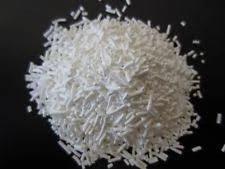
Understanding E435 Emulsifier and Its Applications in Food Industry
Understanding E435 Emulsifier A Comprehensive Overview
Emulsifiers play a pivotal role in the food industry, cosmetics, and various other products. One of the most commonly used emulsifiers is E435, also known as polyoxyethylene (20) sorbitan monostearate, or simply polysorbate 60. This article delves into the characteristics, applications, safety, and regulatory status of E435, providing a comprehensive guide for those interested in understanding this versatile emulsifier.
What is E435?
E435 is a non-ionic emulsifier derived from sorbitol and stearic acid. It belongs to a class of compounds that facilitate the blending of water and oil, enabling the creation of stable emulsions. The 'E' in E435 signifies its classification as a food additive within the European Union, where it has been assigned an E number for regulatory purposes. The number '435' indicates its specific identity among various food additives.
Characteristics of E435
E435 is characterized by its ability to reduce the surface tension between ingredients, which is essential for creating stable emulsions. It is water-soluble and oil-soluble, making it a versatile additive for various formulations. The polysorbate component contributes to its emulsifying properties, while the stearate aspect enhances its compatibility with fats and oils.
The emulsifier is capable of forming transparent solutions and can operate effectively across a range of temperatures and pH levels. This flexibility makes E435 a favorite among food scientists and product developers.
Applications of E435
e435 emulsifier

E435 is widely utilized in the food industry, particularly in the production of confectionery items, dairy products, baked goods, dressings, and sauces. It helps to maintain uniform consistency, improve texture, and enhance the overall mouthfeel of products. In addition to food, E435 finds applications in cosmetics and personal care products, including lotions, creams, and hair care products, where it promotes smooth application and prevents separation of ingredients.
In the pharmaceutical industry, E435 is used as an emulsifier in various formulations, enabling the mixing of active ingredients with carriers or solvents. Its flexibility allows formulators to create stable and effective products across diverse applications.
Safety and Regulatory Status
E435 has been evaluated for safety by various regulatory agencies. The European Food Safety Authority (EFSA) and the U.S. Food and Drug Administration (FDA) consider E435 safe for consumption when used within prescribed limits. Studies have shown that oral consumption of polysorbates has a low toxicity profile, and it is generally recognized as safe (GRAS) for food use.
Despite its safety profile, it’s essential to understand that excessive consumption of emulsifiers, including E435, can lead to gastrointestinal discomfort in some individuals. As with any food additive, moderation is key.
Conclusion
E435 emulsifier is a crucial component in many food and cosmetic products, contributing to stability, texture, and overall quality. Its ability to emulsify a range of ingredients and maintain homogeneity is invaluable in various formulations. The safety evaluations conducted by regulatory bodies support its use in consumer products, affirming its status as a safe additive when utilized appropriately.
As the food and cosmetic industries continue to evolve, the demand for effective emulsifiers like E435 will likely persist. Understanding the properties and applications of this emulsifier can empower consumers and manufacturers alike to make informed choices that enhance product quality and performance. Whether in a delicious salad dressing or a luxurious skin cream, E435 plays an integral role in shaping the textures and experiences of modern living.
-
Aluminum Hydroxide: Quality Gels & Dried Gel AntacidNewsAug.31,2025
-
Buy High-Quality Trichloroisocyanuric Acid for Sale | TCCA 90% SupplierNewsAug.30,2025
-
Pure Sodium Dichloroisocyanurate Dihydrate | Powerful DisinfectantNewsAug.29,2025
-
Industrial Chemicals: Quality & Purity for Every IndustryNewsAug.28,2025
-
Nitrile Rubber Honoring Strict Production StandardsNewsAug.22,2025
-
Aspartame Ingredients Honoring Food Safety ValuesNewsAug.22,2025
-
Fertilizer for Balanced Plant NutritionNewsAug.22,2025
Hebei Tenger Chemical Technology Co., Ltd. focuses on the chemical industry and is committed to the export service of chemical raw materials.
-

view more DiethanolisopropanolamineIn the ever-growing field of chemical solutions, diethanolisopropanolamine (DEIPA) stands out as a versatile and important compound. Due to its unique chemical structure and properties, DEIPA is of interest to various industries including construction, personal care, and agriculture. -

view more TriisopropanolamineTriisopropanolamine (TIPA) alkanol amine substance, is a kind of alcohol amine compound with amino and alcohol hydroxyl, and because of its molecules contains both amino and hydroxyl. -

view more Tetramethyl Thiuram DisulfideTetramethyl thiuram disulfide, also known as TMTD, is a white to light-yellow powder with a distinct sulfur-like odor. It is soluble in organic solvents such as benzene, acetone, and ethyl acetate, making it highly versatile for use in different formulations. TMTD is known for its excellent vulcanization acceleration properties, which makes it a key ingredient in the production of rubber products. Additionally, it acts as an effective fungicide and bactericide, making it valuable in agricultural applications. Its high purity and stability ensure consistent performance, making it a preferred choice for manufacturers across various industries.





